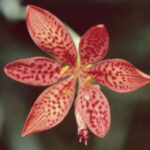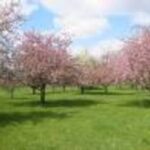I planted a beach plum seedling this spring, but I do admit that I don’t really expect the fruit to be very exciting. I planted mine because it is so pretty, and because beach plums will grow with very little care. If I’m lucky, I’ll also get a crop of small, sweet plums.
The leaves of beach plum resemble those of a Damask plums, which caused some early settlers in the Eastern seaboard to mistake this wild American native plum for the trees they left behind in their English gardens. Unfortunately, the fruit does not resemble the plums from that venerable tree, although an occasional bush will have tasty fruits. The fruits of the beach plum are much smaller than most domestic plums. Most fruits will be from 1/2 inch to 1 inch in diameter, and the flavor will vary from one plant to the next, unless you buy a cloned cultivar. Most beach plum bushes bear deep blue fruit, but this too can vary, and some fruits are purple, red or yellow. The taste tends to be astringent, but some are sweet and juicy, with the taste you expect in a plum.
I intend to grow my new beach plum as a bush, rather than a small tree, and I hope it will follow the family’s characteristic and spread to create a small thicket and act as an attractive screen in front of an unattractive fence. The plant shouldn’t grow much higher than six feet, although some can get as high as ten or fifteen feet. Careful pruning can keep them small. The bush will begin to bloom soon after the apple tree, and it will be covered by a cloud of white petals. The plants are covered with so many flowers, in fact, that the beach plum is often grown for it’s ornamental value alone.
In late summer or early fall the bush will often be covered with ripe purple, red or blue fruit, although it may fail to set fruit some years. This plant is remarkably tolerant of difficult environments, and does grow naturally on ocean beaches where it lives in poor, dry soil and is buffeted by wind. Although they can put up with poor conditions, they will grow best and give you the best show of flowers and fruit if you give them a moderately good soil and keep their soil moist. If you plant one of these bushes as part of your edible landscape, you’ll want to pick a sunny spot with good drainage. For an informal hedge, you can plant beach plums four to five feet apart. The blossoms are usually self-fertile.
Because this is such a rugged plant, you will rarely, if ever, need to spray it to protect it from insects or disease. If you don’t want the plant to spread, you can summer prune the horizontal branches to keep them from touching the ground and rooting. In the winter you’ll want to remove any dead or damaged branches, and keep the bush open for good air circulation. Wood older than three years can be removed, because it will no longer bear fruit.
You can’t count on the beach plum to give you fruit every year, although you will always get a spectacular show of blooms in the spring. If you do get fruit, be sure to leave it on the bush until it is completely ripe. Plums, including beach plums, will not continue to ripen after they are picked. You can make plum jelly from the fruits if you have too many to eat fresh.
The first named cultivar of the beach plum was ‘Bassett’s American’, developed in 1872 by William Bassett. Luther Burbank also took an interest in this rugged plant, and tried to create a hybrid between the beech and domestic plums to produce a larger, more ornamental variety. Cornell University is now working on the development of a beach plum variety that can be grown commercially. You can find a list of nurseries that offer this plant on their website, at http://www.beachplum.cornell.edu/



